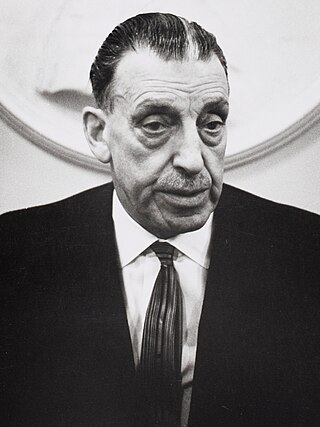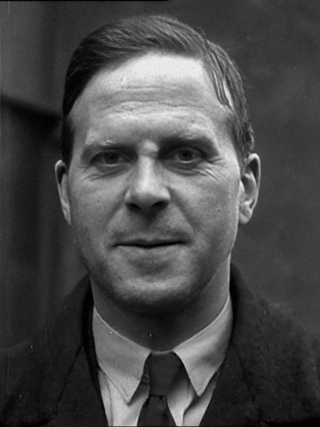
The Irish Civil War was a conflict that followed the Irish War of Independence and accompanied the establishment of the Irish Free State, an entity independent from the United Kingdom but within the British Empire.

Éamon de Valera was an Irish statesman and political leader. He served several terms as head of government and head of state and had a leading role in introducing the 1937 Constitution of Ireland.

The Irish Free State, also known by its Irish name Saorstát Éireann, was a state established in December 1922 under the Anglo-Irish Treaty of December 1921. The treaty ended the three-year Irish War of Independence between the forces of the Irish Republic – the Irish Republican Army (IRA) – and British Crown forces.

William Thomas Cosgrave was an Irish Fine Gael politician who served as the president of the Executive Council of the Irish Free State from 1922 to 1932, leader of the Opposition in both the Free State and Ireland from 1932 to 1944, leader of Fine Gael from 1934 to 1944, founder and leader of Fine Gael's predecessor, Cumann na nGaedheal, from 1923 to 1933, chairman of the Provisional Government from August 1922 to December 1922, the president of Dáil Éireann from September 1922 to December 1922, the minister for Finance from 1922 to 1923 and minister for Local Government from 1919 to 1922. He served as a Teachta Dála (TD) from 1921 to 1944. He was a Member of Parliament (MP) for the Kilkenny North constituency from 1918 to 1922.

Seán Francis Lemass was an Irish Fianna Fáil politician who served as Taoiseach and Leader of Fianna Fáil from 1959 to 1966. He also served as Tánaiste from 1957 to 1959, 1951 to 1954 and 1945 to 1948, Minister for Industry and Commerce from 1957 to 1959, 1951 to 1954, 1945 to 1949 and 1932 to 1939 and Minister for Supplies from 1939 to 1945. He served as a Teachta Dála (TD) from 1924 to 1969.

The 1921 Anglo-Irish Treaty, commonly known in Ireland as The Treaty and officially the Articles of Agreement for a Treaty Between Great Britain and Ireland, was an agreement between the government of the United Kingdom of Great Britain and Ireland and representatives of the Irish Republic that concluded the Irish War of Independence. It provided for the establishment of the Irish Free State within a year as a self-governing dominion within the "community of nations known as the British Empire", a status "the same as that of the Dominion of Canada". It also provided Northern Ireland, which had been created by the Government of Ireland Act 1920, an option to opt out of the Irish Free State, which the Parliament of Northern Ireland exercised.

The Irish Republic was an unrecognised revolutionary state that declared its independence from the United Kingdom in January 1919. The Republic claimed jurisdiction over the whole island of Ireland, but by 1920 its functional control was limited to only 21 of Ireland's 32 counties, and British state forces maintained a presence across much of the north-east, as well as Cork, Dublin and other major towns. The republic was strongest in rural areas, and through its military forces was able to influence the population in urban areas that it did not directly control.
The Second Dáil was Dáil Éireann as it convened from 16 August 1921 until 8 June 1922. From 1919 to 1922, Dáil Éireann was the revolutionary parliament of the self-proclaimed Irish Republic. The Second Dáil consisted of members elected at the 1921 elections, but with only members of Sinn Féin taking their seats. On 7 January 1922, it ratified the Anglo-Irish Treaty by 64 votes to 57 which ended the War of Independence and led to the establishment of the Irish Free State on 6 December 1922.

The Irish state came into being in 1919 as the 32 county Irish Republic. In 1922, having seceded from the United Kingdom of Great Britain and Ireland under the Anglo-Irish Treaty, it became the Irish Free State. It comprised 26 counties with 6 counties under the control of Unionists which became Northern Ireland in 1921. Bunreacht na hEireann 1937 constitution renamed the 26 states 'Ireland'. In 1949, only 26 counties explicitly became a republic under the terms of the Republic of Ireland Act 1948, definitively ending its tenuous membership of the British Commonwealth. In 1973 the Republic of Ireland joined the European Communities (EC) as a member state which would later become the European Union (EU).

James Ryan was an Irish medical doctor, revolutionary and politician who served in every Fianna Fáil government from 1932 to 1965, successively as Minister for Agriculture (1932–1947), Health and Social Welfare, and Finance (1957–1965). He served as a Teachta Dála (TD) for Wexford from 1918 to 1922 and 1923 to 1965, and as senator from 1965 to 1969. He was a member of Sinn Féin until he joined Fianna Fáil upon that party's foundation in 1926.
The government of the 9th Dáil was successively the 8th Executive Council of the Irish Free State and the 1st government of Ireland. They were led by Éamon de Valera, first as President of the Executive Council and then as Taoiseach. It was formed after the 1937 general election held on 1 July, the same day the new Constitution of Ireland was approved in a plebiscite. Fianna Fáil were continuing in office as a single-party government as they had since the 1932 general election. The 8th Executive Council lasted for 162 days until the coming into operation of the new constitution and the 1st Government lasted for 184 days.
Patrick Smith was an Irish Fianna Fáil politician, who served as a Teachta Dála from 1923 until 1977; a tenure of 53 years, the longest in the state. He held a number of ministerial positions within the governments of Éamon de Valera and Seán Lemass.

Following the establishment of the Irish Free State, three deep water Treaty Ports at Berehaven, Spike Island, and Lough Swilly were retained by the United Kingdom in accordance with the Anglo-Irish Treaty of 6 December 1921.

The current Constitution of Ireland came into effect on 29 December 1937, repealing and replacing the Constitution of the Irish Free State, having been approved in a national plebiscite on 1 July 1937 with the support of 56.5% of voters in the then Irish Free State. The Constitution was closely associated with Éamon de Valera, the President of the Executive Council of the Irish Free State at the time of its approval.
The Irish Land Commission was created by the British crown in 1843 to "inquire into the occupation of the land in Ireland. The office of the commission was in Dublin Castle, and the records were, on its conclusion, deposited in the records tower there, from whence they were transferred in 1898 to the Public Record Office". It took on the role of a rent fixing commission in 1881 under the Land Law (Ireland) Act 1881. For a century it was the body responsible for re-distributing farmland in most of Ireland. It was formally abolished in 1999.
The Anglo-Irish Trade Agreement was signed on 25 April 1938 by Ireland and the United Kingdom. It aimed to resolve the Anglo-Irish Trade War which had been on-going from 1933.
Comhairle na dTeachtaí was an Irish republican parliament established by opponents of the 1921 Anglo-Irish Treaty and the resulting Irish Free State, and viewed by republican legitimatists as a successor to the Second Dáil. Members were abstentionist from the Third Dáil established by the pro-Treaty faction. Just as the First Dáil established a parallel Irish Republic in opposition to the British Dublin Castle administration, so Comhairle na dTeachtaí attempted to establish a legitimatist government in opposition to the Provisional Government and Government of the Irish Free State established by the Third Dáil. This legitimatist government, called the Council of State, had Éamon de Valera as president. In 1926 de Valera resigned as president, left the Sinn Féin party and founded Fianna Fáil, which in 1927 entered the Fourth Dáil. Comhairle na dTeachtaí, never more than a symbolic body, was thereby rendered defunct.

Patrick Moylett (1878–1973) was a 20th-century Irish nationalist who, during the initial armistice negotiations to end the Anglo-Irish war, briefly served as president of the Irish Republican Brotherhood during late-1920. A successful businessman in County Mayo and County Galway, he was a close associate of Arthur Griffith and frequently travelled to London acting as a middleman between Sinn Féin and officials in the British government. He ran a business that was used as a front to import armaments for the cause and held that many of those that became closest associates of Éamon de Valera during the civil war rift had at one time worked for the British. Particularly that Erskine Childers despite his involvement with the Asgard and his close association with Éamon de Valera had been in the direct pay of the Admiralty Naval Intelligence Service up till 1916 before becoming secretary to the Éamon de Valera led treaty discussions.
Fianna Fáil was founded on 23 March 1926 when a group of Dáil deputies led by Éamon de Valera split from the original Sinn Féin. This happened because de Valera's motion calling for elected members be allowed to take their seats in the Dáil, if and when the controversial Oath of Allegiance was removed, failed to pass at the Sinn Féin Ard Fheis. The new party adopted its name on 2 April of the same year. From the formation of the first Fianna Fáil government on 9 March 1932 until the 2011 general election, the party was in power for 61 of 79 years. Its longest continuous period in office was 15 years and 11 months. Its single longest period out of office, in that time, has been four years and four months. All eight of its party's leaders have served as Taoiseach. It was the largest party in Dáil Éireann at every general election from the 1932 general election until the 2011 general election, when it suffered the worst defeat of a sitting government in the history of the Irish state.

The Copley Street riot occurred on 13 August 1934, at the Copley Street Repository, Cork, Ireland after Blueshirts opposed to the collection of annuities from auctioned cattle rammed a truck through the gate of an ongoing cattle auction. The Broy Harriers opened fire and one man, 22 year old Michael Lynch, was killed and several others injured.












